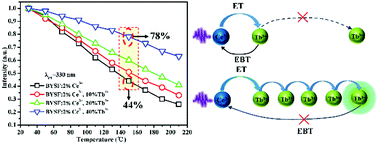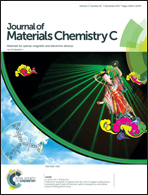Simultaneously tuning the emission color and improving thermal stability via energy transfer in apatite-type phosphors
Abstract
Developing phosphors with high quantum efficiency and superior thermal stability is still a challenge for phosphor-converted white light-emitting diodes (w-LEDs). Energy transfer between ions is usually utilized to tune the emission wavelength. In this study, we demonstrate that in addition to the tunable emission color, an improved thermal stability can be achieved by energy transfer from Ce3+ to Tb3+ in Ce3+ and Tb3+ codoped Ba2Y3(SiO4)3F (BYSF:Ce3+,Tb3+) phosphors without quantum efficiency loss, which is ascribed to the combined effect of fast energy transfer within the nearest Ce3+–Tb3+ pairs via electric dipole–quadrupole interactions, and the following energy diffusion among the Tb3+ ions. An efficient energy transfer from Ce3+ to Tb3+ results in the novel green phosphor BYSF:2%Ce3+,40%Tb3+ with an internal quantum efficiency of as high as 83.12%. In addition, a w-LED lamp was fabricated to explore its possible application in w-LEDs based on near UV LEDs. Our results indicate that fast energy transfer to Tb3+ may provide an alternative way of improving the thermal stability of phosphors.



 Please wait while we load your content...
Please wait while we load your content...